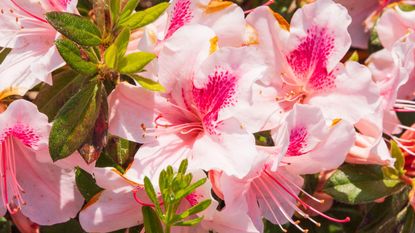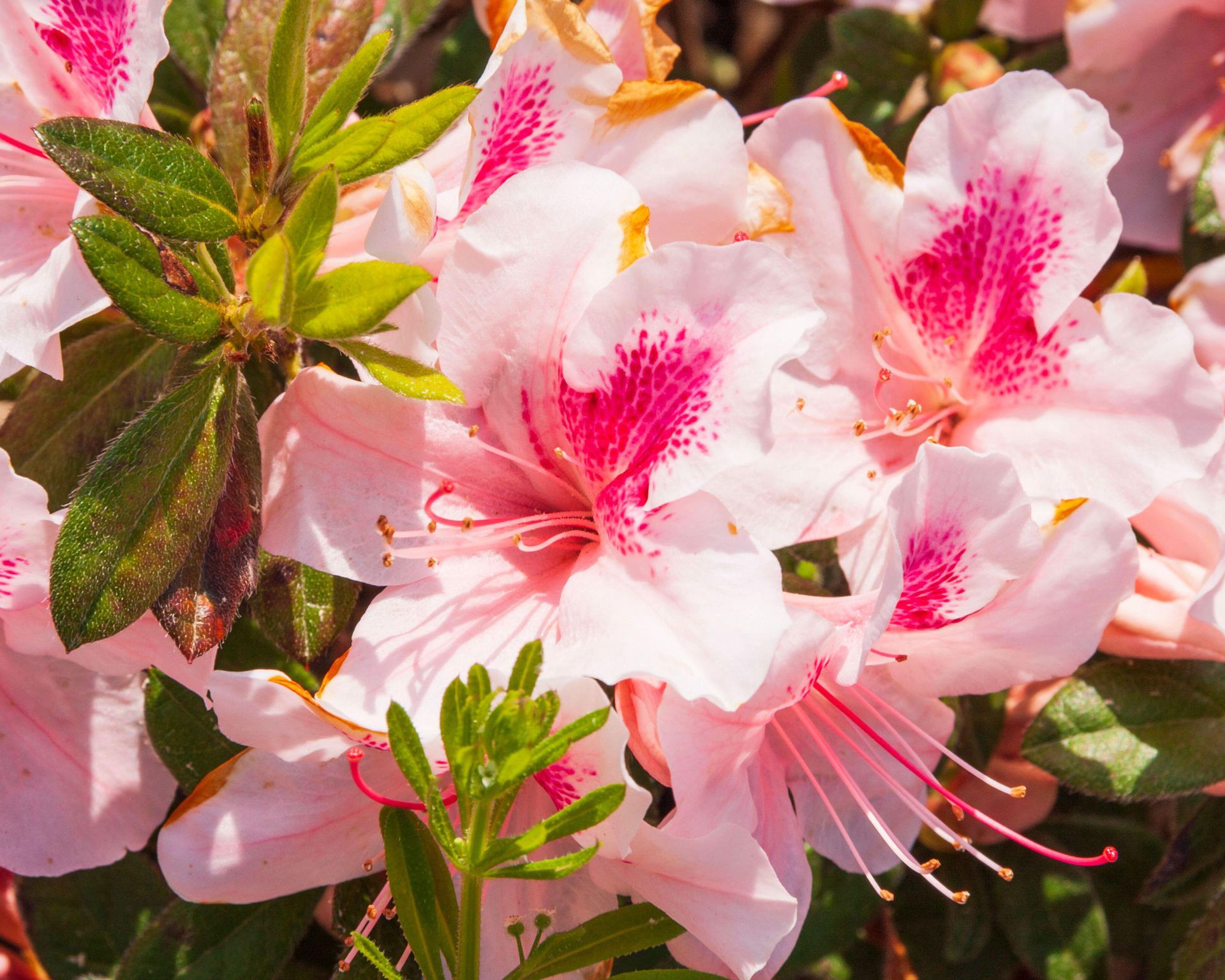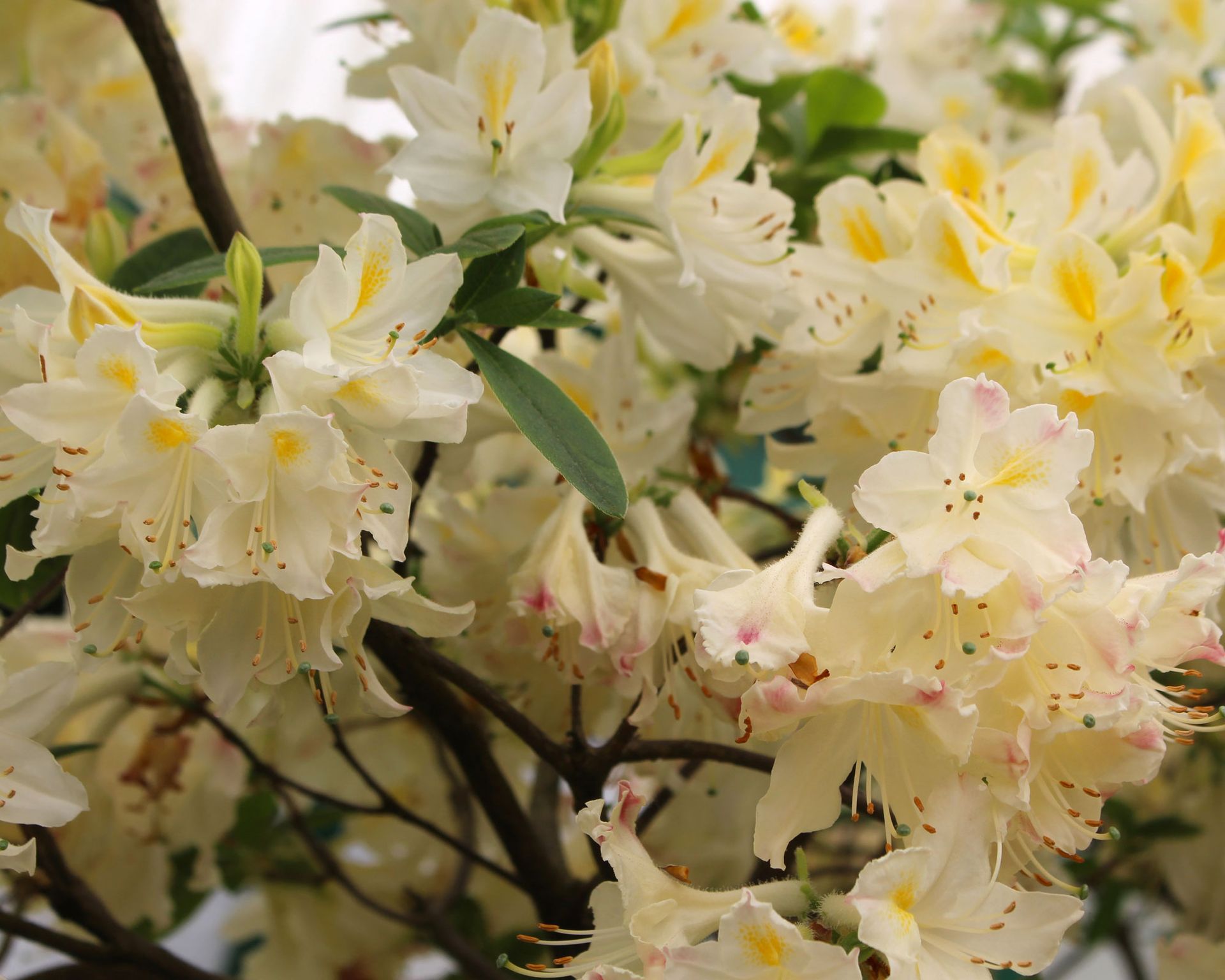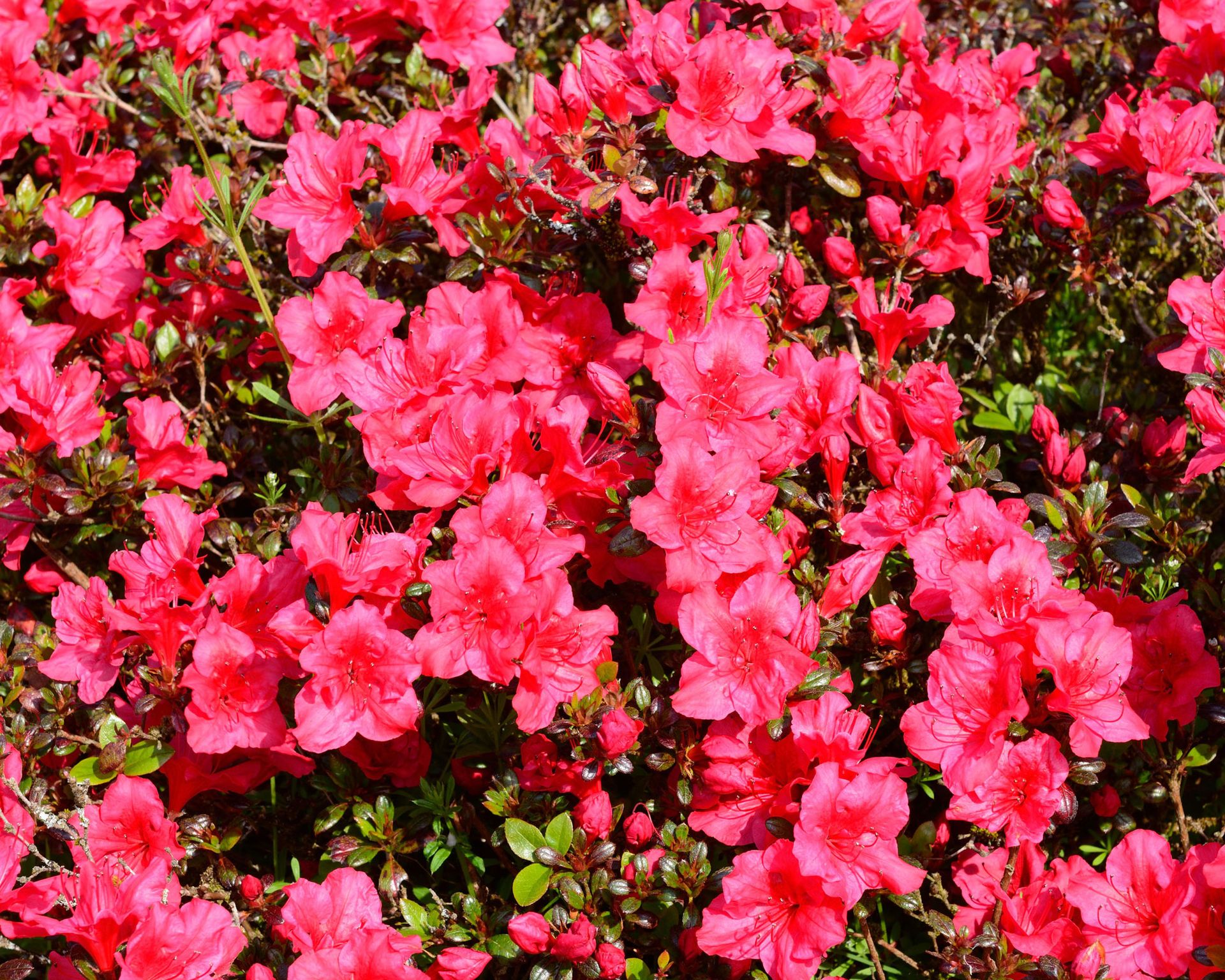How to care for azaleas – a guide to looking after these gorgeous shrubs
Find out how to care for azaleas and their brightly colored blooms will soon become the super stars of your Spring garden

There are a few tricks for how to care for azaleas - and a little knowledge goes a long way. Azaleas are a valuable addition to any garden. As well as looking good, they rarely outgrow their space and reliably produce dazzling color year after year. They are compact, long lived and relatively undemanding as long as you get their basic requirements right.
In small gardens they are ideal for adding color and structure to areas of mixed planting in a shady spot, look stunning with the spotlight on them as individual specimens and also grow well in pots. In bigger gardens they look awesome planted in sweeping drifts. Some azaleas are suitable for growing as houseplants too, where they always prefer the coldest room.
Azaleas are ideal for modern gardens as their clusters of exotic-looking flowers come in vivid crimson, orange and yellow tones as well as white and soft pastel pink and lilac. If you like dark drama they also come in purple. A few are bicolored, striped or flecked to mix up the magic.
Most azaleas have simple trumpet-shaped flowers but some have extra petals creating lush double flowers. Some varieties are also scented. There are evergreen ones that retain their leaves all the year round, as well as deciduous varieties which lose their leaves in winter.
All of this means you're spoiled for choice when it comes to picking an azalea for your flower bed, balcony, courtyard or terrace. By the way, azaleas are also part of the rhododendron family, which can cause confusion, so here's everything you need to know about choosing one of these bright and beautiful shrubs.
How to care for azaleas

10 reasons to love azaleas
Azaleas are exceptionally versatile shrubs and a must-have for any garden. When it comes to how to choose plants for your garden, you can use larger varieties for landscaping, while the smallest ones will grow happily in a pot for years.
Originally from Asia, their exotic flowers are an eye-catching feature and come in a fantastic range of colours. Let's count the ways we love these gorgeous easy going shrubs.
- They produce long-lasting flowers in spring that covers the bush in a mass of color.
- Whether your garden is sunny or shady there will be an azalea to suit your space. Some azaleas thrive in sunny spots, while others do better in shade.
- If you're a balcony, terrace or courtyard gardener you don't need to miss out as there are compact varieties that will thrive in a container.
- If you have a bigger space azaleas are the perfect shrubs for landscaping.
- Depending on the variety, azaleas bloom from early February right through the summer months.
- You can also get re-blooming varieties, which flower multiple times during the year.
- They are easy-care shrubs that reward you with lush exotic looking blooms.
- Many varieties are evergreen with dark glossy leaves for year-round interest.
- They rarely need pruning or trimming.
- An old azalea shrub can be brought back to life if it's cut back hard. This will kickstart it into flowering again and give your plant a fresh start.

When to plant azaleas
The best time to plant azaleas is late spring or early fall. They should never be planted when the ground is waterlogged or frozen - a key trick for any variety when wondering how to start a flower garden.
When choosing a spot bear in mind that some types of azalea are happy in sun, others in partial shade. All azaleas, however, need an acidic, lime-free soil that's moist but well drained. If azaleas or rhododendrons are already growing happily in your garden, then you can be confident that your new azalea plant will thrive too.
Alternatively look at neighboring gardens to see if azaleas or other acid-loving plants are growing well in your area. If you're uncertain about your soil, test its acidity with a test kit, available from DIY stores and garden centers. Azaleas do best when soil has a pH of 4.5-6.0.

How to plant azaleas
The day before you plant your azalea fertilize it with a liquid plant food that specifies it's suitable for azaleas on the label. These products are known as ericaceous fertilisers, and work for rhododendrons and camellias too.
Azaleas have shallow, spreading root systems, so dig a planting hole just a little deeper than the root ball but twice as wide. Add compost, pine bark or other organic material to improve the soil and make sure you work it in well.
Position your azalea so that the top of the root ball is just a little below the soil level as they are shallow-rooted plants. Back fill the planting hole, firm down the soil well, water generously (you can add more liquid feed at this stage too if you want) then add a layer of mulch around the plant using pine bark or leaf mould to help retain moisture and suppress weeds.

How to care for azaleas
Happily azaleas are undemanding shrubs. They rarely need pruning or trimming, although if they start to look unkempt they can be tidied up after flowering in late spring or early summer.
Re-blooming azalea varieties should be trimmed lightly after their spring show, to encourage new growth for the next round of flowering.
During heatwaves and dry spells azaleas will need watering.
Feed once a year with an ericaceous plant food to help keep your azaleas growing and flowering well.
An annual mulch of pine bark or leaf mould in the fall will help suppress weeds, retain moisture in the soil and keep it acid.
Spring frosts can kill new shoots and flower buds. If frost threatens, cover your plants with a frost blanket or horticultural fleece to protect them.

How do I care for an azalea in a container?
If you live in a mild climate, a container azalea can bloom for up to seven months of the year, from December to June, making it a must for bringing a colorful display right up close to the house.
Use peat-free ericaceous compost for azaleas in pots. Replace the top layer of compost, or repot completely, in spring, and feed with an ericaceous fertilizer. Water with rainwater if you can, as depending on where you live tap water could be too alkaline. If tap water is the only thing available, leave it to stand for half a day before using so that any chlorine evaporates.
Azaleas in pots will need watering regularly and more frequent feeding too with an ericaceous plant food to keep them thriving.
Tidy up any faded flowers but other than that they shouldn't need pruning.
Stand the container on pot feet to ensure good drainage and find a sheltered frost-free spot on the patio.

What’s the difference between an azalea and a rhododendron?
Okay, this one can be a little confusing. All azaleas are rhododendrons, but only some rhododendrons are azaleas. So if you read the botanical name of an azalea on a plant label at the garden center, you will often see the word 'rhododendron' too.
Azaleas are just one of the many groups of plants classified as rhododendrons. They were once considered so different from other rhododendrons that they were given separate classification but this is no longer the case.
There are a couple of things to look out for when differentiating between the two plants. Generally azaleas are smaller than rhododendrons, and they also tend to have much finer foliage.
Can you do bonsai with azalea plants?

Azaleas make brilliant bonsai trees and are widely available to buy. You can also try your hand at creating your own azalea bonsai tree.
Start by pruning the canopy of a small azalea to a miniature tree shape. Then tidy up the roots and transfer to a shallow bonsai dish.
Kurume and Satsuki azalea hybrids make the best bonsai trees. They’re easy to train and wherever you make a cut, they’ll sprout new growth.
5 of our favourite azaleas
There are many different types of azalea to choose from, both in terms of color and how big they grow. Here are some of our favourite varieties of this gorgeous shrub to get started with.
1. Best for blooming twice: Encore 'Autumn Chiffon'

There are azaleas that flower in spring and again later in the season. They are also more cold hardy and heat tolerant than many azaleas.
The best known of these are the 'Encore' Azaleas that are unique in that after the first flush of spring flowers they produce new shoots and new flower buds. This new growth will provide flowers in summer and autumn.
There are now more than 30 varieties and they come in a wide range of both vivid and pastel colours. 'Autumn Chiffon' has light pink blooms with a distinctive splash of dark pink in the center. It's a compact grower bearing huge quantities of flowers in summer and fall.
Buy an Autumn Chiffon azalea here.
2. Best for shade: Kurume 'Hinomayo'

Evergreen azaleas not only enjoy the shade, many actually need the shade as the foliage and flowers may scorch in full sun. Partial or dappled shade is ideal for these varieties.
'Hinomayo' comes in all shades of pink through to deep carmine red. It's a compact, evergreen shrub with a spreading habit and neat, light-green glossy foliage. In early to mid spring, small, funnel-shaped, candy-pink blossoms cover the entire plant in a spectacular show of color.
Buy a Hinomayo azalea here.
3. Best for sun: 'Daviesii'

Some azaleas thrive in sunny sites, some are better in shade, but generally speaking deciduous varieties are more tolerant of sun. However, they will not be happy in either drought or scorching conditions so azaleas in sunny situations must be watered regularly for best results.
'Daviesii' is a finely scented, deciduous azalea of the Ghent hybrid variety. The flower buds are pink at first, opening into a pure white tubular flower. It has a compact, low-growing habit.
Ghent azalea hybrids are winter hardy plants and are the oldest of the deciduous azalea hybrid groups, dating back around 200 years.
Buy a Daviesii here.
4. Best evergreen: Kaempferi 'Damio'

Some azaleas have evergreen foliage, so that in winter the plants still have a presence in the garden. These plants tend to have smaller leaves, need warmer winters and prefer shade.
A very hardy plant that comes from Japan, Kaempferi 'Damio' has lovely large deep orange-pink flowers in June. A very hardy plant, it's semi-evergreen in hard winters which means it will lose its leaves if there's a big freeze. This is the most common native azalea in Japan and easy to grow, suiting most garden situations.
Buy a Damio here.
5. Best for containers: Azalea Japonica ‘Johanna’

This neat little evergreen azalea makes a great choice for a container on the deck or patio as it's so compact. You will be rewarded with a showy display of vivid red flowers in spring and summer too, as the star appeal of the azalea japonica variety is its breathtakingly beautiful blooms.
It's also one of the best azaleas for autumn foliage, with dark shiny leaves turning a bronzy dark red as winter approaches. Remember it will need watering regularly to get the best out of your plant.
Buy a Johanna here.
Where to buy a potted azalea?



Be The First To Know
The Livingetc newsletter is your shortcut to the now and the next in home design. Subscribe today to receive a stunning free 200-page book of the best homes from around the world.
Lifestyle journalist Sarah Wilson has been writing about flowers, plants, and garden design and trends since 2015. Having already studied introductory garden and landscape design as well as a course in floristry she is currently adding to her list of qualifications with an RHS Level 2 course in the Principles of Plant Growth and Development. In addition to livingetc.com, she's also written for homesandgardens.com, gardeningetc.com, Modern Gardens and Country Homes & Interiors magazines.
-
 10 Rules For Decorating Small Spaces - How Designers Create A Cozy Room That Also Boosts The Square Footage
10 Rules For Decorating Small Spaces - How Designers Create A Cozy Room That Also Boosts The Square FootageExperts reveal their tips and tricks on how to combine a welcoming vibe with space-stretching interior design techniques...
By Ruth Doherty Published
-
 'Subtle Gray' Is The New Color Trend Designers Are Using to Replace White — It's So Much Warmer and More Luxe
'Subtle Gray' Is The New Color Trend Designers Are Using to Replace White — It's So Much Warmer and More LuxeIt’s the new shade grabbing designers’ attention and you should know about it. But what is ‘subtle gray’, and how can you use it?
By Raluca Racasan Published

